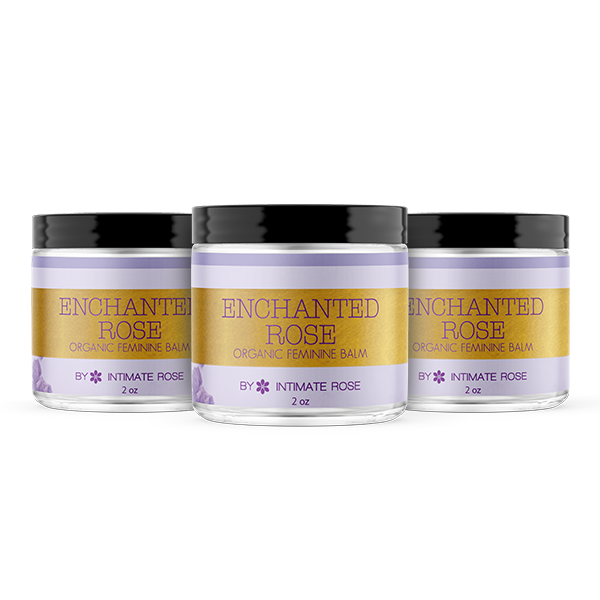Before starting menopause hormone therapy (MHT) to treat symptoms of perimenopause and menopause, it’s helpful to understand the types of hormones used in MHT, and the impact they have on your body, as well as your symptoms.
For instance, some brands use natural hormones that are bioidentical with the hormones made in the body, while others use synthetically made hormones. Read on to understand the difference and make it easier for you and your healthcare provider to determine which type of MHT is right for you.
What Hormones Are Used in Hormone Therapy for Menopause?
Using MHT means you’ll be taking a regular dose of estrogen, progesterone, or testosterone - sometimes a combination of two or all three.
Why is Estrogen Used in MHT?
As women transition from the reproductive stage of life to menopause, the ovaries produce less estrogen. Although it’s primarily known for its role in reproduction, pregnancy, and the menstrual cycle, estrogen also supports the bones, muscles, skin, brain, heart, and vaginal health.
Consequently, as estrogen levels decline during perimenopause, symptoms such as irregular menstruation, difficulty regulating body temperature, mood swings, anxiety or depression, poor sleep, fatigue, muscle and joint pain, and vaginal dryness may arise.
Although not outwardly visible, bone density and cardiovascular health are also known to diminish with decreasing estrogen levels. Once women reach menopause (when menstruation has not occurred for 12 months in a row) and estrogen production is minimal, the likelihood of osteoporosis, loss of muscle mass, and heart disease increases in postmenopausal women.
Estrogen-based MHT is, therefore, commonly prescribed to alleviate symptoms during perimenopause, provide a better quality of life for women transitioning into menopause, and support bone and heart health postmenopause.
Why is Progesterone Used in MHT?
In addition to producing less estrogen during perimenopause, the body produces less progesterone. Throughout the reproductive years, estrogen and progesterone work in tandem to support menstruation, reproduction, the early stages of pregnancy, and lactation. Progesterone also stabilizes mood, promotes sleep, and helps to build bone.
Therefore, decreased levels of progesterone can cause an increase in anxiety during perimenopause and menopause, while also contributing to symptoms such as insomnia and mood instability.
Supplementing progesterone in small amounts with or without estrogen can help alleviate these symptoms.
Progesterone is also used in MHT to counteract the effects of supplemented estrogen on the uterine lining and prevent endometrial cancer.
Why is Testosterone Used in MHT?
Although typically thought of as a “male” hormone, women actually have more testosterone in their bodies than estrogen, and levels are known to start decreasing well before perimenopause and menopause.
Linked to a healthy libido, brain function, energy, memory, and sleep, testosterone is also connected to bone health, lean muscle mass, and even vaginal and vulvar health.
Testosterone is not as commonly prescribed for perimenopause or menopause as estrogen and progesterone, but it plays an integral role in improving moods, energy levels and libido. Low doses of testosterone in the form of a skin cream can be very helpful.
What are Menopause Hormone Therapy Hormones Made From?
The hormones in MHT are currently made from plants or synthetic sources, some of which are combined with bovine gelatin and hormones from horse urine.
Natural estrogen, progesterone, and testosterone are derived from plants like yams and soy. The hormones are extracted in a lab and converted into safe and effective medications. Also known as bio-identical or body-identical, plant-based hormones are chemically & structurally equivalent to the hormones naturally made by the body.
Synthetic hormones are artificial and made in a laboratory to resemble the natural hormones produced by the body, but they have a different molecular structure. Because they are derived from synthetic sources, their physiological interaction can impact the body differently.
Women considering MHT for perimenopause or menopause are advised to speak with their healthcare provider about the benefits, risks, and side effects of bioidentical hormones compared to synthetic hormones.
Hormonal and Non Hormonal Menopause Relief

Are Bioidentical Hormones in MHT Safer than Synthetic Hormones?
Research shows that both bioidentical hormones and synthetically manufactured and animal-derived hormones are very safe. There are subtle differences between bioidentical and synthetic hormones that may make one more appropriate for an individual than another.
For instance, MHT containing bioidentical hormones poses less risk of blood clotting and strokes when compared with synthetic hormones and therefore may be preferred in a patient at higher risk of clot.
Patients with very heavy and bothersome vaginal bleeding may be offered synthetic progestin over bioidentical progesterone, as synthetics are much more effective at controlling bleeding.
Are There Different Types of MHT?
As hormone production declines in perimenopause, it does not happen uniformly, nor is it the same for every woman. Estrogen and progesterone production can rise and fall irregularly during this time, causing sporadic fluctuations and intensified symptoms.
Therefore, MHT is prescribed in various combinations, doses, and types to cater to each woman’s needs. MHT doses might also be modified depending on a woman’s age, progression through menopause, and severity of symptoms.
Systemic and Local MHT: What’s the Difference?
MHT is either prescribed as systemic, meaning it affects the entire body, or local, which means it treats only one area of the body.
Local Hormone Therapy
Local hormone therapy is typically administered as a vaginal suppository, cream, or ring to relieve genitourinary symptoms related to the bladder, vagina, vulva, or urethra.
These can include vaginal dryness, irritation, increased bladder infections, and discomfort during sex. Estrogen creams can be bioidentical or synthetic, while suppositories or rings are bioidentical.
Intrarosa suppositories also contain dehydroepiandrosterone (DHEA), a bioidentical plant-derived hormone combined with coconut and palm oil. DHEA is the “parent” hormone of estrogen and testosterone and converts to both within the urogenital tissues.
Types of systemic MHT generally include the following:
Estrogen Patches, Gels, or Sprays
When taking systemic MHT, using transdermal estrogen (patches, gels, or sprays) has been proven to pose less risk of blood clotting than MHT in pill or tablet form. All transdermal estrogen therapy also contains bioidentical hormones.
Estrogen Pills
As one of the oldest types of estrogen therapy, estrogen pills are well-studied and effectively treat menopause symptoms for many women. However, they are known to slightly increase the risk of blood clotting in some women and are not recommended for women with liver issues.
Oral estrogen is produced from synthetic or bioidentical hormones.
Estrogen-only systemic MHT is normally prescribed for women who have had a hysterectomy. For women who still have a womb, progesterone is recommended in conjunction with estrogen to prevent endometrial hyperplasia and uterine cancer.
Progesterone-only pills, Patches and Intrauterine Device (IUD)
As mentioned above, progesterone is commonly prescribed together with estrogen to treat perimenopause and menopause symptoms and lower the risk of uterine cancer. Women who have had a hysterectomy don’t require progesterone, but it can still be used to alleviate symptoms caused by low progesterone.
It is important to note that bioidentical progesterone is not easily absorbed by the skin. Therefore, it is only available as a pill after being micronized (powdered and suspended in oil). Alternatively, synthetic progestin can be administered via oral pill, transdermal patch or IUD.
Inserted through the vagina and into the uterus, and changed every 5-8 years, the progestin IUD releases the required dose of progestin to counteract the risks of supplemented estrogen on the uterine lining.
Combined MHT
Prescribed as pills or patches, combined MHT contains estrogen and progesterone. The estrogen in combined MHT patches can be synthetic or bioidentical. Because bioidentical progesterone is not well absorbed by the skin, synthetically produced progestin is used instead.
Additionally, estrogen and progesterone are often taken at the same time, but in separate formulations. For instance, a bioidentical estrogen patch may be taken along with bioidentical progesterone pills. In contrast to estrogen pills, micronized progesterone pills are not known to increase the risk of blood clotting.
Testosterone Cream
Applied as a gel or cream onto the skin of the thigh, groin, wrist, or forearm, testosterone is used to treat low libido, and sometimes low energy or mood associated with menopause. Testosterone creams are generally made with bioidentical hormones.

Get your personalized HRT plan!

Get your personalized HRT plan!
The Benefits and Risks of Menopause Hormone Therapy
Although an older study incorrectly concluded that MHT could increase the risk of breast cancer in all women, research carried out since then has debunked this conclusion. In recent years, studies have concluded that the benefits of MHT outweigh the risks for most women.
While estrogen therapy in pill form can slightly increase the risk of venous and pulmonary blood clotting, transdermal estrogen applied with patches, gels, or sprays does not impose the same risk.
In addition to alleviating menopause symptoms such as hot flashes, night sweats, poor sleep, fatigue, irritability, anxiety, depression, and vaginal dryness, MHT also helps to prevent osteoporosis and loss of muscle mass in later life. Some evidence also suggests that MHT can prevent heart disease in postmenopausal women.
What is The Best Type of MHT?
The best type of MHT will vary from woman to woman depending on their symptoms, overall health, and family history.
Combined MHT (estrogen and progesterone), for instance, is recommended for women who still have a uterus, but women who have had a hysterectomy can safely take estrogen-only MHT.
Estrogen patches, gels, and sprays are less risky for those susceptible to or worried about venous and pulmonary blood clots.
When considering MHT, speak openly with your healthcare provider about your symptoms, underlying medical conditions, and family history to help determine the right type and dose of MHT for you.
Conclusion
The hormones used in MHT typically include some form of estrogen, progesterone, and testosterone. Depending on their symptoms, however, not all women require all three. Some MHT brands also use plant-based bioidentical hormones whereas others use artificial or animal-derived hormones.
When contemplating MHT to relieve symptoms of perimenopause or menopause, it’s always best to schedule a consultation with a female health practitioner or menopause expert to determine which combination and dose of MHT is right for you.
This content is intended solely for informational purposes and should not be considered medical advice. It is not meant to replace the guidance of a qualified healthcare professional. Be sure to consult with your doctor to discuss the potential risks and benefits of any treatment options.
References
The Menopause Society – Hormone Therapy - https://menopause.org/patient-education/menopause-topics/hormone-therapy
Cleveland Clinic – Estrogen - https://my.clevelandclinic.org/health/body/22353-estrogen
National Library of Medicine - Physiology, Progesterone - https://www.ncbi.nlm.nih.gov/books/NBK558960/
Menopause Balance - The Importance of Testosterone for Women – https://www.balance-menopause.com/menopause-library/importance-of-testosterone-for-women/
National Library of Medicine - The History of Estrogen Therapy - https://www.ncbi.nlm.nih.gov/pmc/articles/PMC7334883/
National Library of Medicine - The bioidentical hormone debate: are bioidentical hormones (estradiol, estriol, and progesterone) safer or more efficacious than commonly used synthetic versions in hormone replacement therapy? - https://pubmed.ncbi.nlm.nih.gov/19179815/

Get your personalized HRT plan!












